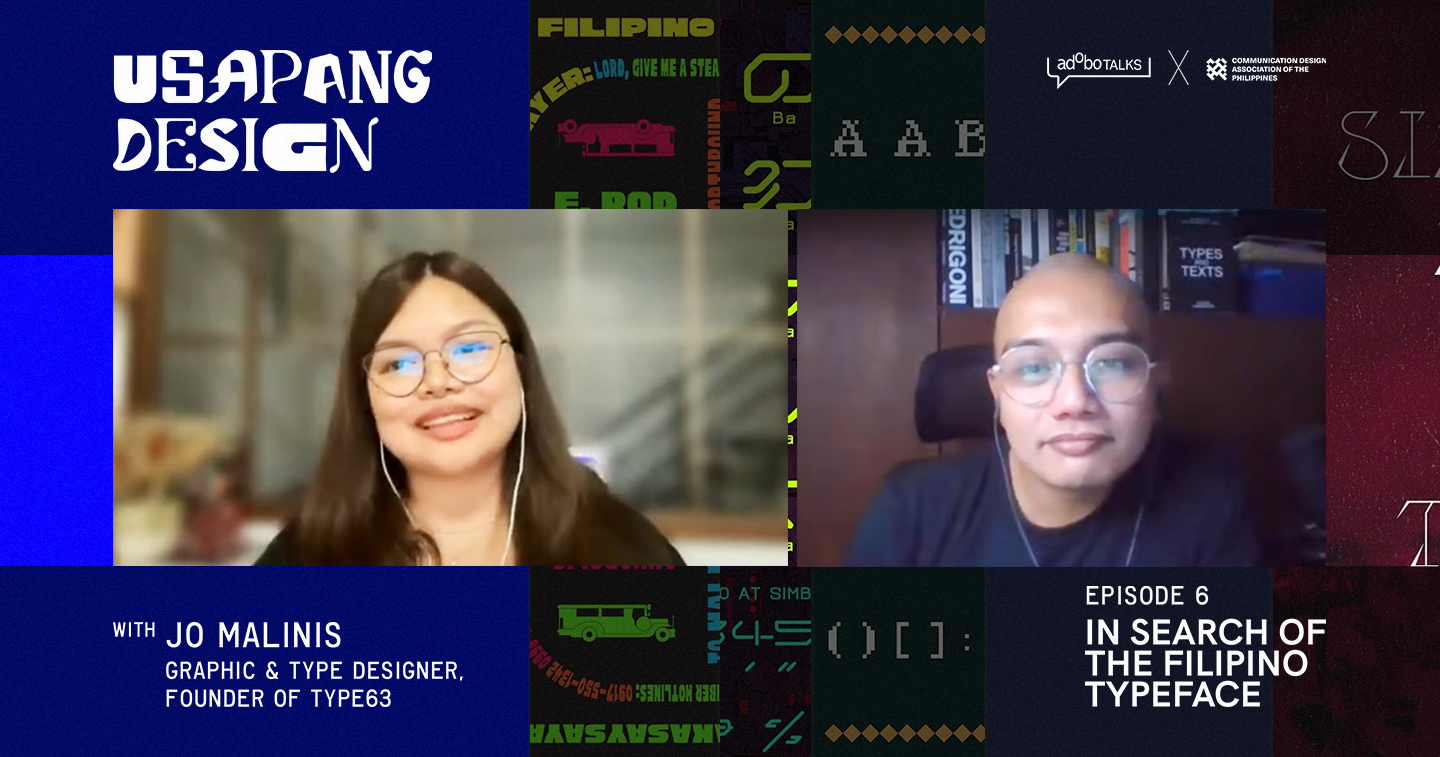MANILA, PHILIPPINES — What does the Filipino typeface look like? What even is the Filipino typeface? And can we see Philippine identity in type design?
In the latest episode of adobo Talks x Usapang Design, Jo Malinis answers those questions and more as she walks us through the basics of type design, different approaches to creating type and who makes them, and understanding how Filipino typeface reflects the Philippine’s identity.
Jo is a graphic designer, type designer, and educator from the Philippines. In her many years of working on branding and graphic design projects, she has become especially interested in letterforms and how they reflect the concepts and themes that she has encountered and been inspired by in her career as a designer. In 2020, she founded Type63, an initiative that features and celebrates Filipino-type design.
What is typography and how is type made?
“Typography is also an art form, but in this case, it arranges letters or typefaces in a clear, readable, and visually appealing manner,” Jo explained at the beginning of the discussion. “It mostly deals with letters that are meant to be repeated over and over. That’s why usually you only see [typefaces] in a digital format.”
Jo explains that the creation of type has three main parts: conceptualization, construction, and presentation. For the talk, Jo said that she will be focusing on the first phase only, specifically in answering the question of what Filipino typeface is and looks like.
Conceptualization is the phase where the sketches, mood boards, and research come in to figure out how to execute an idea through a typeface. In discussing this phase in relation to Filipino typography, Jo went through the different approaches that Filipino type designers have taken to come up with their typefaces.
Approaches to Filipino-themed type design
“As someone who has been collecting Filipino-made typefaces at Type63, I noticed a couple of similarities in terms of how designers approach their Filipino-themed concepts,” she said.
One common approach is by referencing existing lettering or calligraphic work in their surroundings. For example, Bawal Sans by Together We Design was inspired by silk-screen-stenciled signages one can see everywhere in the metro, particularly in DIY ones on posts. Another instance is LL Karatula by LLoydiecat which was inspired by handpainted signages at palengkes or painted on the back of tricycles. The most recognized and widely used example, though, is Cubao Free and Quiapo Free by Aaron Amar, a font inspired by jeepney signages.
Another approach Jo presented is the taking of visual cues from Philippine culture. Inandan by Uncurated Studio, for example, is a geometric display typeface based on the beadwork and weaving patterns found in the accessories and garments of different ethnic groups in Mindanao. She also used as an example the font that she created, Terno, which is inspired by the shapes and curves reminiscent of the traditional Filipiniana garment of the same name. Jo also took us through more examples that took cues from the Philippines’ flora and fauna.
Some type designers attempt to represent non-tangible ideas. Diane Diana’s Bisdak, for example, is a typeface that was created to represent Cebu City and the strength of delivery when one speaks Bisaya. In contrast to Bisdak’s bold and strong look is Suba by Les Torts, a typeface inspired by the river of Zamboanga Peninsula, which has flowy lines meant to mimic the movement of the water.
Jo also shared her typeface, Yor, as well as its sharp look is one based on a common joke-threat that Filipino siblings would hear from their mothers when they fight: Ayan, kutsilyo, magsaksakan na lang kayo.
Reviving and preserving writing systems is the last approach to Filipino-themed design that she presented. However, Jo observed that the only examples of these she’s seen are ones reviving Baybayin, like Babayin Deko by Lloydiecat, Korporal by Aaron Amar, and Babayin Cyber by Lucius Felimus.
“This isn’t to say that these are the only Baybayin typefaces that exist or that I’ve come across. That’s definitely not the case,” she clarified. “But what I have observed is that Baybayin is the only Philippine writing system that has active designers pursuing it.”
So, what is the Filipino typeface?
As Jo returned to the questions she posed at the start of the presentation — What does the Filipino typeface look like? What is the Filipino typeface? — she admitted that even after going through all the approaches and typefaces she’s encountered, it’s still difficult to answer these questions.
But she also shared that, eventually, she found peace through Adrian Panadero’s talk at Type63 where he said, “Type serves to visualize culture. It serves to visualize meaning […] A singular [Filipino] look or a singular identity is constructed. It’s formed. It’s not as organic because in that process you’re weeding out kung sino yung kasama at kung sino yung hindi kasama.”
Even the vast range of typefaces Jo presented today is just a tiny sampling of thousands of Filipino-made typography. It’s impossible to deem one more culturally significant than the other. This is especially true for such a diverse country like the Philippines which boasts of thousands of islands, cultures, and languages.
“Choosing just one typeface to encompass all of these islands with so many different cultures and specificities per region does it a disservice,” Jo said. “There should not be just one but there should be all.”
Jo ended her talk by saying that the type community’s role is to encourage other designers to join in and let their own voices be heard. It’s important to hear what each Filipino type designer has to say, regardless of their location, gender, skill, or level of commitment to the craft. That, after all, is how the community has come up with such a diverse arsenal of typefaces, all stemming from a different part of the country’s rich history and culture.
“There’s always space for everyone,” she said. “And everyone can contribute to the evolving idea of what Filipino type is and where it’s headed.








